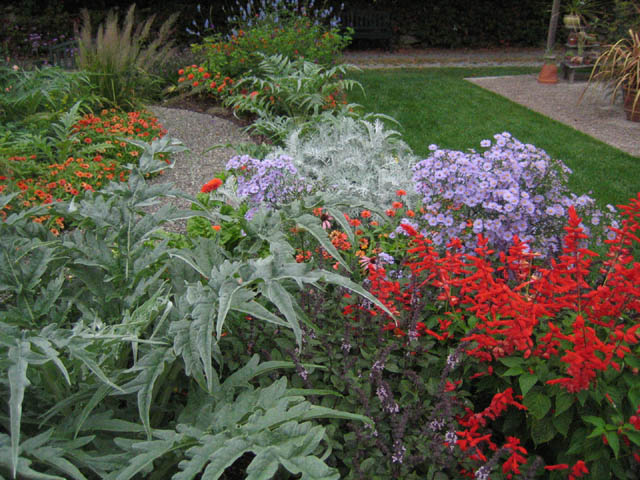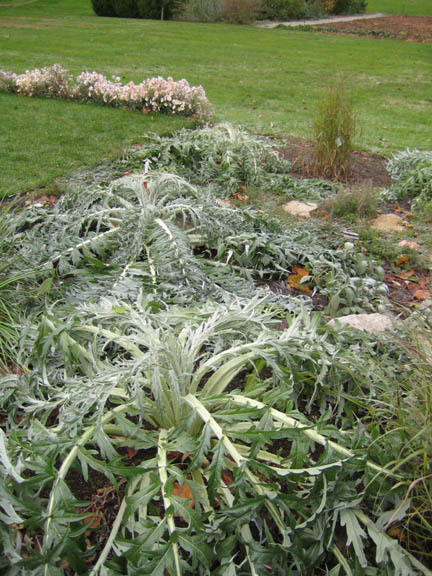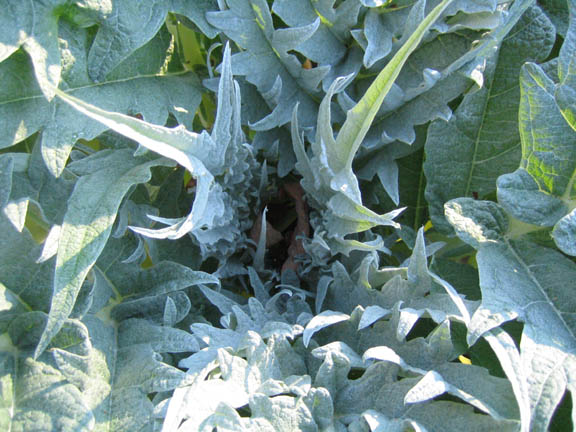Cynara cardunculus (or What to do with a cardoon)
 We planted a lot of cardoons this year. A lot. And now that the season is done, Julie (who doesn’t love giant horsey things in the garden – especially when they’re everywhere flopping big leaves on delicate things – but who generously let us plant them all in the first place) has been asking us, “When are you going to cut them back?, Can you cut them back today?, How about now?, Are you going to dig them up?, Maybe you should dig them up.” So yesterday when they looked frost-flat I did a little research to find out what to do to them for the winter (Gail and I would like *some* to come back…) and I learned all sorts of new things about cardoons. To give credit where credit is due, most of what I learned I found on this site.
We planted a lot of cardoons this year. A lot. And now that the season is done, Julie (who doesn’t love giant horsey things in the garden – especially when they’re everywhere flopping big leaves on delicate things – but who generously let us plant them all in the first place) has been asking us, “When are you going to cut them back?, Can you cut them back today?, How about now?, Are you going to dig them up?, Maybe you should dig them up.” So yesterday when they looked frost-flat I did a little research to find out what to do to them for the winter (Gail and I would like *some* to come back…) and I learned all sorts of new things about cardoons. To give credit where credit is due, most of what I learned I found on this site.
Cardoons are winter hardy perennials to about zone 7b but with protection might come back into the zone 6’s (Gail had one come back a few years ago). They are best planted by seed and the first year they establish their tap root, grow gorgeous gray and spiny foliage (some might call it horsey) and the second year they become even more gigantic (they can reach 7′) and they flower. The flowers are thistle-ish, artichoke-like wildlife magnets – birds and bees, etc reportedly can’t get enough of them. But once they flower, the foliage goes downhill for at least a month before sending up new leaves from the base (I suspect that happens more reliably in long growing seasons.)
I have all sorts of appreciation for their ornamental function in the garden but had no idea about the culinary uses and frankly the spiny stalks are about as appealing to me to eat as a fully clothed porcupine. I found out that cooking them for supper is more complicated than just breaking off a stalk and sauteing it up. They must be blanched first. A couple of weeks before the first frost you tie them up in a wheatsheaf bundle and wrap them in burlap or cardboard so just the top feathers stick out. Restricting photosynthesis evidently sweetens the stems and cooked up, they’ll taste like artichoke heart. The entire plant is harvested after the 2-3 weeks of blanching by cutting the base just below soil level. Cook prep is a little high maintenance too – you must remove the spines (duh!), cut the stalks into sections and submerge them in “acidulated water”. That was another learn-something-new-today thing for me – acidulated water is, well, just what it sounds like – lemon water. And that keeps them from turning ugly oxidized colors before cooking. My interest flagged at the recipes because I’m not a cook but if you are, there’s probably all sorts of ways to make tasty things (that I would love to eat) from this most outstanding (horsey?) ornamental vegetable! Have you ever eaten cardoon? Is it worth the wait and the work?
After all the reading up, I’m still not ready to put them to bed for the winter. The flattened leaves popped back up as the temperatures rose and I think they’re still too architecturally pretty to behead. When the leaves really go to mush, we’ll cut them off, throw a little mulch around our favorites and hope for the best!


